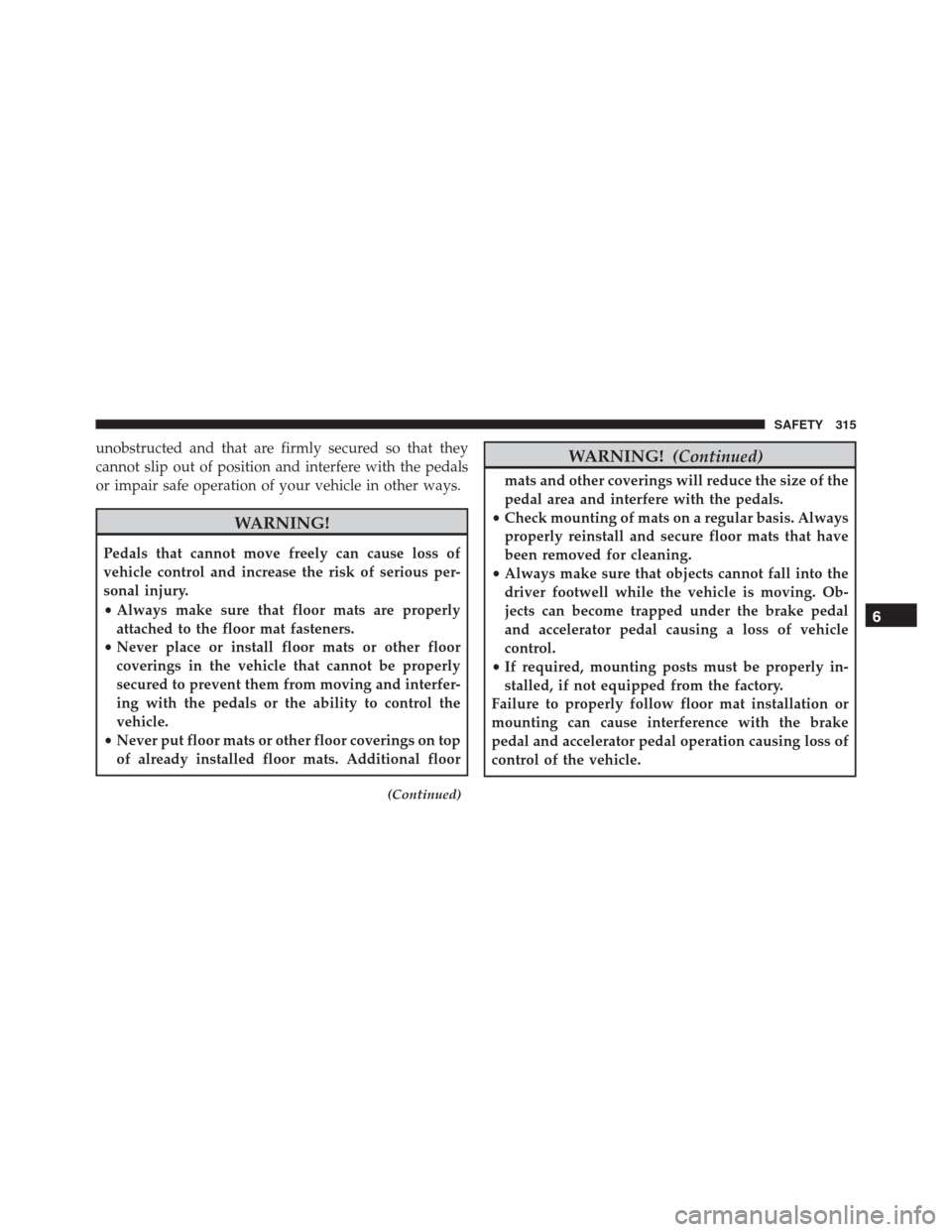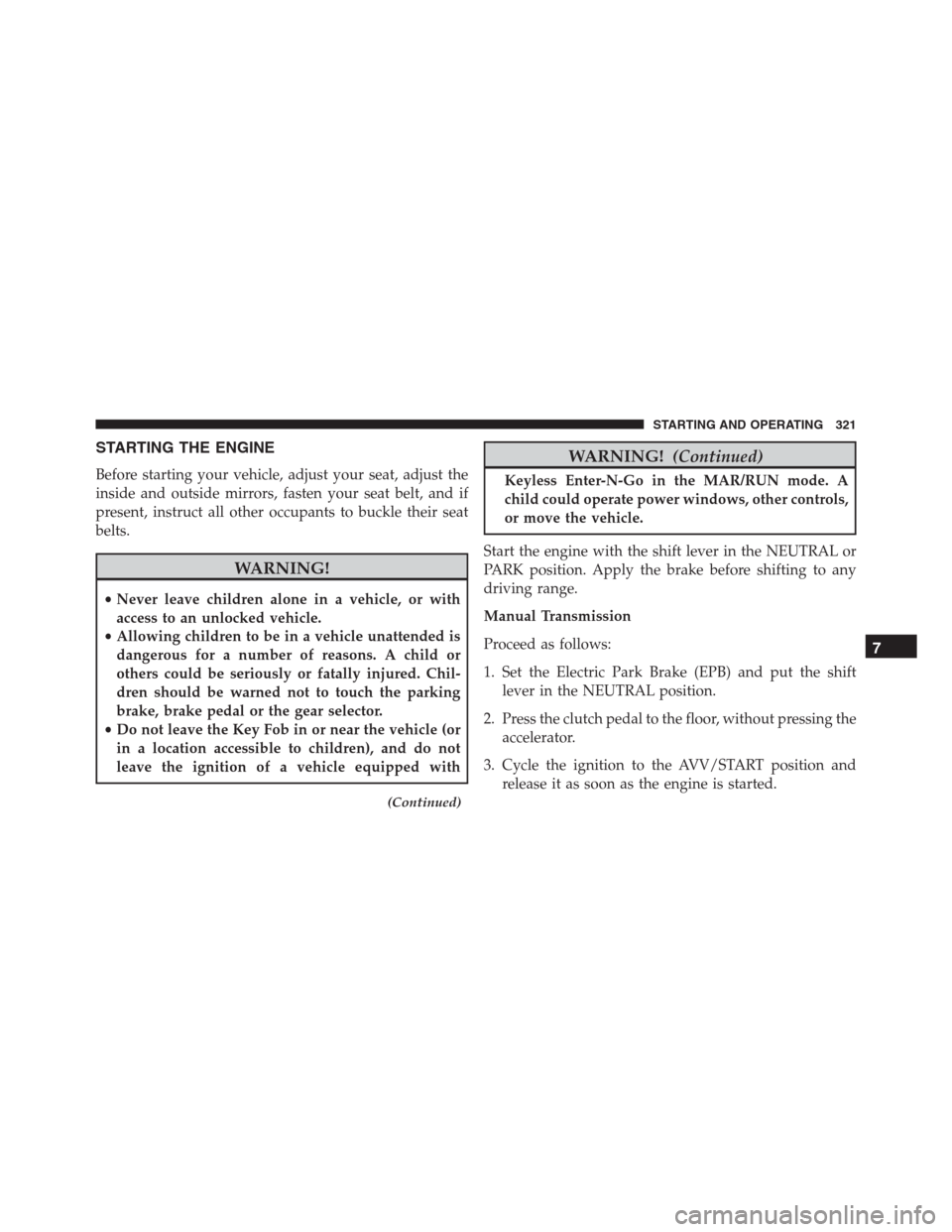Page 317 of 688

unobstructed and that are firmly secured so that they
cannot slip out of position and interfere with the pedals
or impair safe operation of your vehicle in other ways.
WARNING!
Pedals that cannot move freely can cause loss of
vehicle control and increase the risk of serious per-
sonal injury.
•Always make sure that floor mats are properly
attached to the floor mat fasteners.
•Never place or install floor mats or other floor
coverings in the vehicle that cannot be properly
secured to prevent them from moving and interfer-
ing with the pedals or the ability to control the
vehicle.
•Never put floor mats or other floor coverings on top
of already installed floor mats. Additional floor
(Continued)
WARNING!(Continued)
mats and other coverings will reduce the size of the
pedal area and interfere with the pedals.
•Check mounting of mats on a regular basis. Always
properly reinstall and secure floor mats that have
been removed for cleaning.
•Always make sure that objects cannot fall into the
driver footwell while the vehicle is moving. Ob-
jects can become trapped under the brake pedal
and accelerator pedal causing a loss of vehicle
control.
•If required, mounting posts must be properly in-
stalled, if not equipped from the factory.
Failure to properly follow floor mat installation or
mounting can cause interference with the brake
pedal and accelerator pedal operation causing loss of
control of the vehicle.
6
SAFETY 315
Page 318 of 688
Periodic Safety Checks You Should Make Outside
The Vehicle
Tires
Examine tires for excessive tread wear and uneven wear
patterns. Check for stones, nails, glass, or other objects
lodged in the tread or sidewall. Inspect the tread for cuts
and cracks. Inspect sidewalls for cuts, cracks, and bulges.
Check the wheel nuts for tightness. Check the tires
(including spare) for proper cold inflation pressure.
Lights
Have someone observe the operation of brake lights and
exterior lights while you work the controls. Check turn
signal and high beam indicator lights on the instrument
panel.
Door Latches
Check for proper closing, latching, and locking.
Fluid Leaks
Check area under vehicle after overnight parking for fuel,
engine coolant, oil, or other fluid leaks. Also, if gasoline
fumes are detected, or if fuel or brake fluid leaks are
suspected, the cause should be located and corrected
immediately.
316 SAFETY
Page 319 of 688
STARTING AND OPERATING
CONTENTS
�STARTING THE ENGINE................321
▫Tip Start Feature......................322
▫If Engine Fails To Start.................322
▫Cold Weather Operation................323
▫Extended Park Starting..................324
▫After Starting — Warming Up The Engine. . . .325
▫Stopping The Engine...................325
▫Turbocharger “Cool Down” —
If Equipped..........................326
�ENGINE BREAK-IN RECOMMENDATIONS . . .326�ELECTRIC PARK BRAKE (EPB)............327
▫Auto Park Brake......................332
▫SafeHold...........................332
▫Brake Service Mode....................333
�MANUAL TRANSMISSION...............334
▫Shifting.............................336
▫Downshifting........................337
�AUTOMATIC TRANSMISSION............339
▫Shift Lever..........................341
▫Gear Ranges.........................343
7
Page 320 of 688

▫Transmission Limp Home Mode...........349
▫Key Ignition Park Interlock...............350
▫Brake/Transmission Shift Interlock System. . . .350
�SPEED CONTROL — IF EQUIPPED.........351
▫Activation...........................352
▫Setting A Desired Speed.................352
▫Deactivation.........................353
▫Resume Speed........................353
▫Varying The Speed.....................353
▫Accelerating For Passing................355
�FOUR WHEEL DRIVE — JEEP ACTIVE DRIVE
(4WD) AND JEEP ACTIVE DRIVE LOW
(4WD LOW)...........................355
▫Four Wheel Drive (4x4).................356�SELEC-TERRAIN.......................358
▫Mode Selection Guide..................358
�FORWARD COLLISION WARNING (FCW)
WITH MITIGATION — IF EQUIPPED.......360
▫Forward Collision Warning (FCW) With
Mitigation Operation — If Equipped.......360
▫Turning FCW ON Or OFF...............363
▫Changing FCW Sensitivity...............364
▫FCW Limited Warning..................364
▫Service FCW Warning..................365
▫Precautions While Driving With FCW.......366
▫General Information...................370
�LANESENSE — IF EQUIPPED.............370
▫LaneSense Operation...................370
318 STARTING AND OPERATING
Page 323 of 688

STARTING THE ENGINE
Before starting your vehicle, adjust your seat, adjust the
inside and outside mirrors, fasten your seat belt, and if
present, instruct all other occupants to buckle their seat
belts.
WARNING!
•Never leave children alone in a vehicle, or with
access to an unlocked vehicle.
•Allowing children to be in a vehicle unattended is
dangerous for a number of reasons. A child or
others could be seriously or fatally injured. Chil-
dren should be warned not to touch the parking
brake, brake pedal or the gear selector.
•Do not leave the Key Fob in or near the vehicle (or
in a location accessible to children), and do not
leave the ignition of a vehicle equipped with
(Continued)
WARNING!(Continued)
Keyless Enter-N-Go in the MAR/RUN mode. A
child could operate power windows, other controls,
or move the vehicle.
Start the engine with the shift lever in the NEUTRAL or
PARK position. Apply the brake before shifting to any
driving range.
Manual Transmission
Proceed as follows:
1. Set the Electric Park Brake (EPB) and put the shift
lever in the NEUTRAL position.
2. Press the clutch pedal to the floor, without pressing the
accelerator.
3. Cycle the ignition to the AVV/START position and
release it as soon as the engine is started.
7
STARTING AND OPERATING 321
Page 324 of 688

4. If the engine does not start, place the ignition in the
STOP/OFF position and wait 10-15 seconds before
attempting to restart the engine.
Automatic Transmission
Proceed as follows:
1. Set the Electric Park Brake (EPB) and put the shift
lever in the PARK or NEUTRAL position.
2. Press on the brake pedal, without pressing the accel-
erator.
3. Cycle the ignition to the AVV/START position and
release it as soon as the engine is started.
4. If the engine does not start, place the ignition in the
STOP/OFF position and wait 10-15 seconds before
attempting to restart the engine.Tip Start Feature
Do notpress the accelerator. Cycle the ignition switch
briefly to the AVV/START position and release it. The
starter motor will continue to run but will automatically
disengage when the engine is running.
If Engine Fails To Start
WARNING!
Never pour fuel or other flammable liquid into the
throttle body air inlet opening in an attempt to start
the vehicle. This could result in flash fire causing
serious personal injury.
If the engine fails to start after you have followed the
�Normal Starting�or�Extreme Cold Weather�procedure,
and has not experienced an extended park condition as
identified in�Extended Park Starting�procedure it may
be flooded. Push the accelerator pedal all the way to the
322 STARTING AND OPERATING
Page 329 of 688

CAUTION!
Never use Non-Detergent Oil or Straight Mineral Oil
in the engine or damage may result.
NOTE:A new engine may consume some oil during its
first few thousand miles (kilometers) of operation. This
should be considered a normal part of the break-in and
not interpreted as a problem.
ELECTRIC PARK BRAKE (EPB)
Your vehicle is equipped with an Electric Park Brake
System (EPB) that offers simple operation, and some
additional features that make the parking brake more
convenient and useful.The parking brake is primarily intended to prevent the
vehicle from rolling while parked. Before leaving the
vehicle, make sure that the parking brake is applied.
Also, be certain to leave the transmission in PARK.
The EPB switch is located in the center console.
You can engage the EPB in two ways;
•Manually, by applying the park brake switch.
•Automatically, by enabling the Auto Park Brake fea-
ture in the customer programmable features section of
the Uconnect settings or in “Safe Hold” conditions.7
STARTING AND OPERATING 327
Page 330 of 688

To apply the EPB manually, pull up on the switch
momentarily. You may hear a slight whirring sound from
the back of the vehicle while the EPB engages. Once the
parking brake is fully engaged, the BRAKE warning
lamp in the instrument cluster and an indicator on the
switch will illuminate. If your foot is on the brake pedalwhile you apply the EPB, you may notice a small amount
of brake pedal movement. The EPB can be applied even
when the ignition switch is in the STOP/OFF position
but the BRAKE warning lamp will not illuminate, how-
ever, it can only be released when the ignition switch is in
the MAR/RUN position.
NOTE:The EPB fault lamp will illuminate if the EPB
switch is held for longer than 10 seconds (static condi-
tions) or 30 seconds (dynamic conditions) in either the
released or applied position. The light will extinguish
upon releasing the switch.
If the Auto Park Brake feature is enabled, the EPB will
automatically engage whenever the transmission is
moved into PARK, or with a manual transmission, when
the ignition switch is in the STOP/OFF position. If your
foot is on the brake pedal, you may notice a small amount
of brake pedal movement while the EPB is engaging.
Electric Park Brake Switch
328 STARTING AND OPERATING